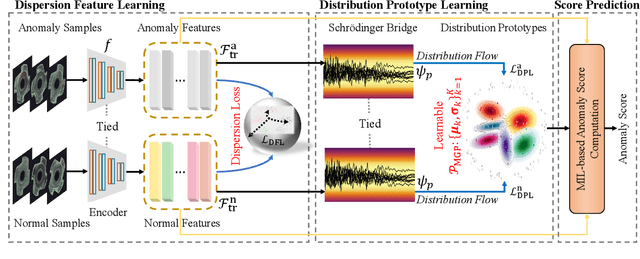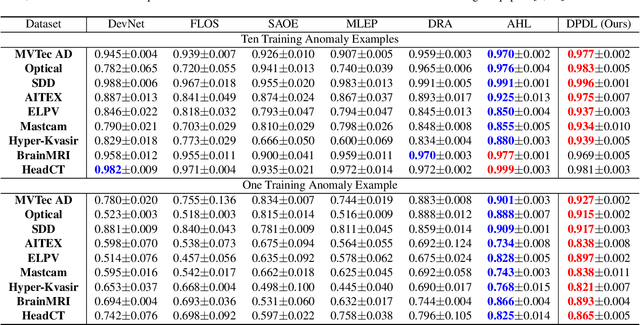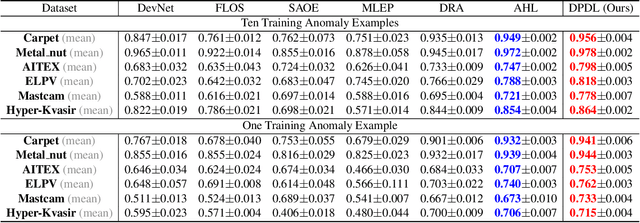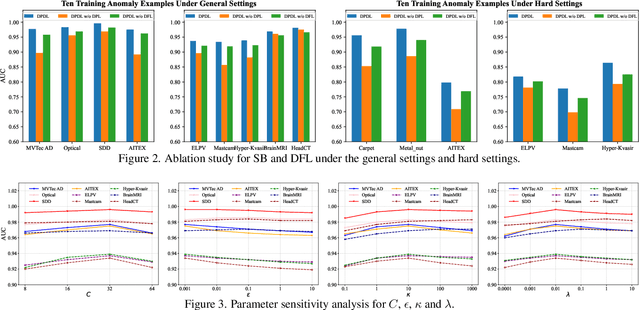Xu Guo
Slim-SC: Thought Pruning for Efficient Scaling with Self-Consistency
Sep 17, 2025Abstract:Recently, Test-Time Scaling (TTS) has gained increasing attention for improving LLM reasoning performance at test time without retraining the model. A notable TTS technique is Self-Consistency (SC), which generates multiple reasoning chains in parallel and selects the final answer via majority voting. While effective, the order-of-magnitude computational overhead limits its broad deployment. Prior attempts to accelerate SC mainly rely on model-based confidence scores or heuristics with limited empirical support. For the first time, we theoretically and empirically analyze the inefficiencies of SC and reveal actionable opportunities for improvement. Building on these insights, we propose Slim-SC, a step-wise pruning strategy that identifies and removes redundant chains using inter-chain similarity at the thought level. Experiments on three STEM reasoning datasets and two recent LLM architectures show that Slim-SC reduces inference latency and KVC usage by up to 45% and 26%, respectively, with R1-Distill, while maintaining or improving accuracy, thus offering a simple yet efficient TTS alternative for SC.
X2Edit: Revisiting Arbitrary-Instruction Image Editing through Self-Constructed Data and Task-Aware Representation Learning
Aug 11, 2025Abstract:Existing open-source datasets for arbitrary-instruction image editing remain suboptimal, while a plug-and-play editing module compatible with community-prevalent generative models is notably absent. In this paper, we first introduce the X2Edit Dataset, a comprehensive dataset covering 14 diverse editing tasks, including subject-driven generation. We utilize the industry-leading unified image generation models and expert models to construct the data. Meanwhile, we design reasonable editing instructions with the VLM and implement various scoring mechanisms to filter the data. As a result, we construct 3.7 million high-quality data with balanced categories. Second, to better integrate seamlessly with community image generation models, we design task-aware MoE-LoRA training based on FLUX.1, with only 8\% of the parameters of the full model. To further improve the final performance, we utilize the internal representations of the diffusion model and define positive/negative samples based on image editing types to introduce contrastive learning. Extensive experiments demonstrate that the model's editing performance is competitive among many excellent models. Additionally, the constructed dataset exhibits substantial advantages over existing open-source datasets. The open-source code, checkpoints, and datasets for X2Edit can be found at the following link: https://github.com/OPPO-Mente-Lab/X2Edit.
IFDECORATOR: Wrapping Instruction Following Reinforcement Learning with Verifiable Rewards
Aug 06, 2025Abstract:Reinforcement Learning with Verifiable Rewards (RLVR) improves instruction following capabilities of large language models (LLMs), but suffers from training inefficiency due to inadequate difficulty assessment. Moreover, RLVR is prone to over-optimization, where LLMs exploit verification shortcuts without aligning to the actual intent of user instructions. We introduce Instruction Following Decorator (IFDecorator}, a framework that wraps RLVR training into a robust and sample-efficient pipeline. It consists of three components: (1) a cooperative-adversarial data flywheel that co-evolves instructions and hybrid verifications, generating progressively more challenging instruction-verification pairs; (2) IntentCheck, a bypass module enforcing intent alignment; and (3) trip wires, a diagnostic mechanism that detects reward hacking via trap instructions, which trigger and capture shortcut exploitation behaviors. Our Qwen2.5-32B-Instruct-IFDecorator achieves 87.43% accuracy on IFEval, outperforming larger proprietary models such as GPT-4o. Additionally, we demonstrate substantial improvements on FollowBench while preserving general capabilities. Our trip wires show significant reductions in reward hacking rates. We will release models, code, and data for future research.
TimeMaster: Training Time-Series Multimodal LLMs to Reason via Reinforcement Learning
Jun 16, 2025Abstract:Time-series reasoning remains a significant challenge in multimodal large language models (MLLMs) due to the dynamic temporal patterns, ambiguous semantics, and lack of temporal priors. In this work, we introduce TimeMaster, a reinforcement learning (RL)-based method that enables time-series MLLMs to perform structured, interpretable reasoning directly over visualized time-series inputs and task prompts. TimeMaster adopts a three-part structured output format, reasoning, classification, and domain-specific extension, and is optimized via a composite reward function that aligns format adherence, prediction accuracy, and open-ended insight quality. The model is trained using a two-stage pipeline: we first apply supervised fine-tuning (SFT) to establish a good initialization, followed by Group Relative Policy Optimization (GRPO) at the token level to enable stable and targeted reward-driven improvement in time-series reasoning. We evaluate TimeMaster on the TimerBed benchmark across six real-world classification tasks based on Qwen2.5-VL-3B-Instruct. TimeMaster achieves state-of-the-art performance, outperforming both classical time-series models and few-shot GPT-4o by over 14.6% and 7.3% performance gain, respectively. Notably, TimeMaster goes beyond time-series classification: it also exhibits expert-like reasoning behavior, generates context-aware explanations, and delivers domain-aligned insights. Our results highlight that reward-driven RL can be a scalable and promising path toward integrating temporal understanding into time-series MLLMs.
SoftCoT++: Test-Time Scaling with Soft Chain-of-Thought Reasoning
May 16, 2025



Abstract:Test-Time Scaling (TTS) refers to approaches that improve reasoning performance by allocating extra computation during inference, without altering the model's parameters. While existing TTS methods operate in a discrete token space by generating more intermediate steps, recent studies in Coconut and SoftCoT have demonstrated that thinking in the continuous latent space can further enhance the reasoning performance. Such latent thoughts encode informative thinking without the information loss associated with autoregressive token generation, sparking increased interest in continuous-space reasoning. Unlike discrete decoding, where repeated sampling enables exploring diverse reasoning paths, latent representations in continuous space are fixed for a given input, which limits diverse exploration, as all decoded paths originate from the same latent thought. To overcome this limitation, we introduce SoftCoT++ to extend SoftCoT to the Test-Time Scaling paradigm by enabling diverse exploration of thinking paths. Specifically, we perturb latent thoughts via multiple specialized initial tokens and apply contrastive learning to promote diversity among soft thought representations. Experiments across five reasoning benchmarks and two distinct LLM architectures demonstrate that SoftCoT++ significantly boosts SoftCoT and also outperforms SoftCoT with self-consistency scaling. Moreover, it shows strong compatibility with conventional scaling techniques such as self-consistency. Source code is available at https://github.com/xuyige/SoftCoT.
MMHCL: Multi-Modal Hypergraph Contrastive Learning for Recommendation
Apr 23, 2025Abstract:The burgeoning presence of multimodal content-sharing platforms propels the development of personalized recommender systems. Previous works usually suffer from data sparsity and cold-start problems, and may fail to adequately explore semantic user-product associations from multimodal data. To address these issues, we propose a novel Multi-Modal Hypergraph Contrastive Learning (MMHCL) framework for user recommendation. For a comprehensive information exploration from user-product relations, we construct two hypergraphs, i.e. a user-to-user (u2u) hypergraph and an item-to-item (i2i) hypergraph, to mine shared preferences among users and intricate multimodal semantic resemblance among items, respectively. This process yields denser second-order semantics that are fused with first-order user-item interaction as complementary to alleviate the data sparsity issue. Then, we design a contrastive feature enhancement paradigm by applying synergistic contrastive learning. By maximizing/minimizing the mutual information between second-order (e.g. shared preference pattern for users) and first-order (information of selected items for users) embeddings of the same/different users and items, the feature distinguishability can be effectively enhanced. Compared with using sparse primary user-item interaction only, our MMHCL obtains denser second-order hypergraphs and excavates more abundant shared attributes to explore the user-product associations, which to a certain extent alleviates the problems of data sparsity and cold-start. Extensive experiments have comprehensively demonstrated the effectiveness of our method. Our code is publicly available at: https://github.com/Xu107/MMHCL.
Consensus Entropy: Harnessing Multi-VLM Agreement for Self-Verifying and Self-Improving OCR
Apr 16, 2025



Abstract:The Optical Character Recognition (OCR) task is important for evaluating Vision-Language Models (VLMs) and providing high-quality data sources for LLM training data. While state-of-the-art VLMs show improved average OCR accuracy, they still struggle with sample-level quality degradation and lack reliable automatic detection of low-quality outputs. We introduce Consensus Entropy (CE), a training-free post-inference method that quantifies OCR uncertainty by aggregating outputs from multiple VLMs. Our approach exploits a key insight: correct VLM OCR predictions converge in output space while errors diverge. We develop a lightweight multi-model framework that effectively identifies problematic samples, selects the best outputs and combines model strengths. Experiments across multiple OCR benchmarks and VLMs demonstrate that CE outperforms VLM-as-judge approaches and single-model baselines at the same cost and achieves state-of-the-art results across multiple metrics. For instance, our solution demonstrates: achieving 15.2% higher F1 scores than VLM-as-judge methods in quality verification, delivering 6.0% accuracy gains on mathematical calculation tasks, and requiring rephrasing only 7.3% of inputs while maintaining overall performance. Notably, the entire process requires neither training nor supervision while maintaining plug-and-play functionality throughout.
Multi-Modal Hypergraph Enhanced LLM Learning for Recommendation
Apr 13, 2025



Abstract:The burgeoning presence of Large Language Models (LLM) is propelling the development of personalized recommender systems. Most existing LLM-based methods fail to sufficiently explore the multi-view graph structure correlations inherent in recommendation scenarios. To this end, we propose a novel framework, Hypergraph Enhanced LLM Learning for multimodal Recommendation (HeLLM), designed to equip LLMs with the capability to capture intricate higher-order semantic correlations by fusing graph-level contextual signals with sequence-level behavioral patterns. In the recommender pre-training phase, we design a user hypergraph to uncover shared interest preferences among users and an item hypergraph to capture correlations within multimodal similarities among items. The hypergraph convolution and synergistic contrastive learning mechanism are introduced to enhance the distinguishability of learned representations. In the LLM fine-tuning phase, we inject the learned graph-structured embeddings directly into the LLM's architecture and integrate sequential features capturing each user's chronological behavior. This process enables hypergraphs to leverage graph-structured information as global context, enhancing the LLM's ability to perceive complex relational patterns and integrate multimodal information, while also modeling local temporal dynamics. Extensive experiments demonstrate the superiority of our proposed method over state-of-the-art baselines, confirming the advantages of fusing hypergraph-based context with sequential user behavior in LLMs for recommendation.
X2I: Seamless Integration of Multimodal Understanding into Diffusion Transformer via Attention Distillation
Mar 08, 2025Abstract:Text-to-image (T2I) models are well known for their ability to produce highly realistic images, while multimodal large language models (MLLMs) are renowned for their proficiency in understanding and integrating multiple modalities. However, currently there is no straightforward and efficient framework to transfer the multimodal comprehension abilities of MLLMs to T2I models to enable them to understand multimodal inputs. In this paper, we propose the X2I framework, which endows Diffusion Transformer (DiT) models with the capability to comprehend various modalities, including multilingual text, screenshot documents, images, videos, and audio. X2I is trained using merely 100K English corpus with 160 GPU hours. Building on the DiT teacher model, we adopt an innovative distillation method to extract the inference capabilities of the teacher model and design a lightweight AlignNet structure to serve as an intermediate bridge. Compared to the teacher model, X2I shows a decrease in performance degradation of less than 1\% while gaining various multimodal understanding abilities, including multilingual to image, image to image, image-text to image, video to image, audio to image, and utilizing creative fusion to enhance imagery. Furthermore, it is applicable for LoRA training in the context of image-text to image generation, filling a void in the industry in this area. We further design a simple LightControl to enhance the fidelity of instructional image editing. Finally, extensive experiments demonstrate the effectiveness, efficiency, multifunctionality, and transferability of our X2I. The open-source code and checkpoints for X2I can be found at the following link: https://github.com/OPPO-Mente-Lab/X2I.
Distribution Prototype Diffusion Learning for Open-set Supervised Anomaly Detection
Feb 28, 2025



Abstract:In Open-set Supervised Anomaly Detection (OSAD), the existing methods typically generate pseudo anomalies to compensate for the scarcity of observed anomaly samples, while overlooking critical priors of normal samples, leading to less effective discriminative boundaries. To address this issue, we propose a Distribution Prototype Diffusion Learning (DPDL) method aimed at enclosing normal samples within a compact and discriminative distribution space. Specifically, we construct multiple learnable Gaussian prototypes to create a latent representation space for abundant and diverse normal samples and learn a Schr\"odinger bridge to facilitate a diffusive transition toward these prototypes for normal samples while steering anomaly samples away. Moreover, to enhance inter-sample separation, we design a dispersion feature learning way in hyperspherical space, which benefits the identification of out-of-distribution anomalies. Experimental results demonstrate the effectiveness and superiority of our proposed DPDL, achieving state-of-the-art performance on 9 public datasets.
 Add to Chrome
Add to Chrome Add to Firefox
Add to Firefox Add to Edge
Add to Edge